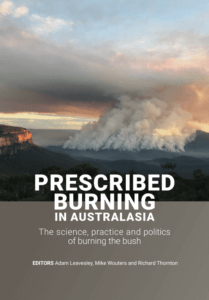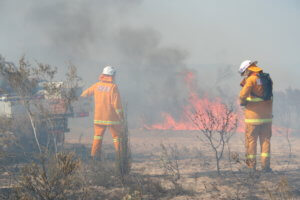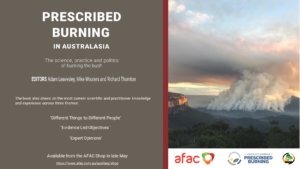BOOK REVIEW: “PRESCRIBED BURNING IN AUSTRALASIA – THE SCIENCE, PRACTICE AND POLITICS OF BURNING THE BUSH”
Editors: Adam Leavesley, Mike Wouters and Richard Thornton
Review by David Bruce, Communications Director for the Bushfire and Natural Hazards Cooperative Research Centre and IAWF board member 
Fire has been a force in the Australian landscape for millennia and prescribed burning has been practiced for at least 50,000 years by the First Peoples. And yet, here we are. Still debating its merits. Still trying to get the square peg of science into the round holes of community values, political ideology and entrenched operational practices. The debates roared around prescribed burning in the Australian summer of 2019-20. Much of this book was written before those fires but the range of views provide a timely frame to review this historic year for fire and plan for what may lie ahead.
In the introductory chapter, editor Dr. Adam Leavesley declares that this book features a broad range of views on the science and practice of prescribed burning, but he adds, it is “not a social science study.”
But it is through the lens of social science that makes this book most interesting. Prescribed burning is, to take the title of his opening, Different Things to Different People. The basic principle of putting fire into the landscape to reduce the risk of larger, uncontrolled wildfire is barely questioned across the 300 pages. The differences arise in how you burn, where you burn, why you burn. And those differences are told by 51 fire and land managers, and researchers, from across Australia and New Zealand.
There is much focus on the use of fire by Indigenous Australians and how much of it is misunderstood by the general population. As Leavesley calls it, it is part of the “whitefella dreaming conversation”; essentially a mythological view held by nonAboriginal people on how the country was burnt pre-European colonization and how that type of burning can and should now be resumed by present day non-Aboriginal land managers. This is not the point of view of Aboriginal people still active in burning practices. Times have changed, the landscape is changed, but, argues Dean Freeman, a Wiradjuri man and a divisional commander in the ACT Parks and Conservation Service, fire management is often too inflexible.
Most of the traditional custodians of southern Australia recognize that times have changed and will be glad for the opportunity to work with conservation agencies and other land managers to manage and burn country within the frameworks that exist today. At the same time, it is hoped that the Australian community recognises that the use of fire was a fundamental skill of Aboriginal people and that the reintroduction of Aboriginal burning to southern Australia has the potential to deliver many benefits to society.
The core of the book has chapters grouped under Evidence-Led Management, with contributions from many of the current leading scientists and practitioners in this field in Australia and New Zealand.
The topics range from the broad to the local. Prescribed burning on central Australian desert land, on the fringe urban settings of capital cities, and in the tropical savannahs. Burning for ecological outcomes. Burning amongst the fire sensitive plants in Tasmania. Burning under the growing influence of climate change. The impacts on forest carbon and water. The impacts on landscape erosion and on native fauna and ants. 
This in-depth analysis is disrupted throughout the book by small Photo Focus features that rely on good photography and minimal text to make a point – on aerial ignition, ignition patterns, smoke management, forestry regeneration burns, burning for Gouldian Finches, the pioneering work of Alan McArthur, and more.
A book that is imbedded with so much evidence-based science dedicates its final 18 chapters – a third of the book, no less – to Expert Opinions. Can there really be that many opinions on how to do prescribed burning? Dr. Kevin Tolhurst, researcher and teacher, calls for more fire in the landscape but laments the lack of skills and resources to achieve this: “The complexity and importance of good fire management is not recognised in most of Australia. Instead, we have opted to use a response-driven management paradigm because it is easier for the public, politicians and media to understand and accept.”
As bushfire took hold on much of the southeast Australian states early this year, the public and political voices, both informed and uninformed, suddenly had long-held opinions on prescribed burning and its impacts on uncontrolled wildfire. On any given day it was in equal parts raised as the solution and pilloried as the cause.
Meanwhile, this year as in any other year, writes co-editor Dr. Richard Thornton, “…many local land management authorities are just getting on with the job – and dealing with the equal mix of complaints and praise on a daily basis.”
Several IAWF connections are present with Dr. Adam Leavesley a Wildfire Contributing Editor, former IAWF Board member Dr. Richard Thornton as a co-editor,
and current Board members, Murray Carter and Naomi Stephens, submitting chapters. The immediate past president of the IAWF Alen Slijepcevic also writes.
This book is the final product of the National Burning Project, which brought together knowledge and practices from across Australia to build a more holistic and
consistent approach to prescribed burning.
Buy from the AFAC Shop: https://www.afac.com.au/auxiliary/shop

